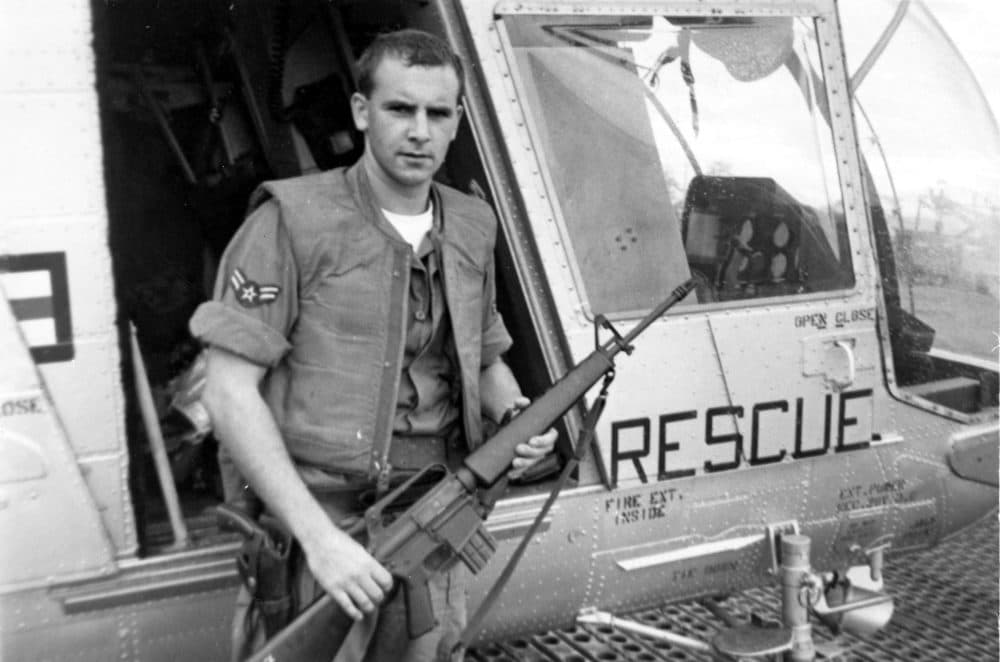Advertisement
'The Last Full Measure' Tells Story Of Hero In Vietnam War
Resume
Editor's Note: This segment was rebroadcast on Memorial Day 2020. That audio is available here.
A new film opening Friday tells the story of a long fight to right an old wrong.
In April 1966, members of the U.S. Army's Charlie Company, 2nd Battalion, 16th Infantry Regiment were tasked with searching out a powerful Viet Cong battalion in Vietnam's dense jungle. Drastically outnumbered, they were soon ambushed by the enemy. It became one of the bloodiest battles of the Vietnam War.
Known as the Battle of Xa Cam My or Operation Abilene, the Viet Cong were at the American’s side, dropping from the trees. But then also descending through those trees was a U.S. Air Force pararescue medic named William Pitsenbarger. In the helicopter above, he made the decision to join the fighters.
Ken Alderson, second in command of the Charlie Company, recalls what he was thinking as he watched Pitsenbarger lower through the thick canopy of trees.
“This guy does not know what he's getting into,” he remembers. “But once your boots meet the ground, it's a different environment.”
Pitsenbarger soon became one of them — a mud soldier sending the wounded back up to the helicopter, waving it off when his fellow airmen wanted him to come as well. He saved nearly 60 lives before losing his own.
Members of Charlie Company, as well as Pitsenbarger’s Air Force comrades, spent years trying to get him a posthumous Medal of Honor. It rarely goes to airmen, and in this case, the Pentagon may not have wanted a reminder of that disastrously planned day.
But the pararescue medic’s friends finally succeeded after 32 years. Writer and director Todd Robinson tells their story in “The Last Full Measure,” with help from Fred Navarro, one of the Vietnam veterans Robinson interviewed for the film.
Navarro says witnessing Pitsenbarger’s descent was like “seeing an angel come down through the jungle to save us.”
The battle continued for so long, the severely wounded Navarro was able to build a bond with Pitsenbarger. He says Pitsenbarger would disappear for a bit to take care of others, but would always return.
Once, Pitsenbarger took off his armed vest to put on Navarro, and even pulled dead U.S. soldiers over him as protection from bullets whizzing by.
Viet Cong snipers ended up killing Pitsenbarger soon after.
Navarro says he wanted to get to Pitsenbarger, but he couldn’t move under the weight of the dead bodies and his injuries.
“Then night fell, and I thought and I wondered all night if he was alive or not,” Navarro says, “And I found out in the morning that he had died.”
Interview Highlights
On how frightening Operation Abilene was
Fred Navarro: “It was total chaos. Can you imagine 700 guns firing at the same time? Some of us could see the enemy. Most of us could not. It was crazy. But Pitsenbarger was crawling and running, trying to take care of the wounded. He would hear the wounded hollering for help and he would run to them and take care of them.”
On seeing Pitsenbarger wave off the helicopters
Navarro: “The pilot waved Pitsenbarger to get on the litter and let’s get out of here. But Pitsenbarger came there to save lives and that's what he was doing. The PJ [pararescue jumpers] model is these things we do, so others may live. He waved the pilot off. And to this day, the pilot doesn't know if Pitsenbarger had got in the litter with the two wounded soldiers, if he had been able to lift off or not.”
On finding out about the pararescue jumpers
Todd Robinson: Yeah, they're called pararescue jumpers or pararescue medics, and they're highly trained combat medics and they're there to evacuate the wounded, tend to their wounds. And as Fred said, these guys will trade their lives for yours. The culture is just replete with stories like this, and it was just irresistible as the subject of a film.”
On hearing the story of Pitsenbarger
Robinson: “[Pitsenbarger’s father] lamented that he had never gotten to see his son fall in love, have a child of his own, because only then could he understand how much his father loved him. And that just knocked me out. I had a seven-year-old son, a three-year-old daughter at the time, and trying to wrap my head around what it would be like to lose one of them. And then I flashback even further to my own dinner table where we often watched in the early 1970s the Vietnam War play out on television. And I realized that my father was deeply concerned that I would soon be a draftable age and that he could lose me to something as existentially impossible to deal with as a draft lottery number. And so when those ideas sort of all came together, it became clear to me that there was a story to tell. And it was the story about not only the combat and the long path to get Pitsenbarger the medal, but it was also about the families that support our fighting men and women.”
Emiko Tamagawa produced and edited this interview for broadcast with Todd Mundt. Serena McMahon adapted it for the web.
This segment aired on January 23, 2020.

